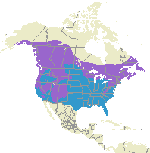 SKC Films Library SKC Films Library |
| SKC Films Library >> Science >> Zoology >> Birds >> Order Passeriformes |
| Red-Breasted Nuthatch Sitta canadensis [sit' tuh kan uh den' sis] Description This small nuthatch is about 4.5 inches long and weighs about 0.35 ounces. It is characterized from other nuthatches by the broad black stripe through the eye and white stripe above that, along with the black cap on its head, bluish-gray back, and rusty-red or brownish tinge on breast and rump. The short tail is characterized by white bands and dark tips on the outer feathers. A strong rear-pointing claw on each foot allows this bird to literally walk down a tree trunk head first, and it can also move around on the underside of a tree branch, with its back to the ground, with no fear of falling off the tree.
Distribution and Habitat This species is found from southeastern Alaska across southern Canada to Newfoundland. Its western range extends into northern California and through the Rocky Mountains; the eastern range extends as far south as North Carolina. The only migratory species in its family, some populations winter in southern Arizona, New Mexico, Texas and northern Florida. Throughout its range this bird prefers coniferous forests with dense understory of saplings, but it can also be found in mixed conifer-deciduous stands, so long as there is a sufficient supply of food.
Diet The red-breasted nuthatch feeds on insects and insect eggs, as well as a variety of conifer seeds. It will regularly store food, especially seeds, when there is an abundance, and will take advantage of a bird feeder that has plenty of large seeds in it. Reproduction Monogamous breeding pairs come together in late winter or early spring. The male courtship display consists of him swaying from side to side with his back to the female and singing to her, along with raising and lowering of the head and tail. The breeding season itself runs from mid-April through early August, depending on geographic location. The nest, which is built by both sexes, is placed inside a cavity dug into a tree stump or the branch of a dead tree, sometimes in a vacant woodpecker hole. Unique to this species is the habit of lining the nest cavity with pine (or similar) resin to protect it from insects and predators; it also surrounds the cavity entrance with pitch, often in successive layers, to further protect the nest. The nest itself is made of grasses, roots, mooses, shredded bark and other plant fibers. Five to eight small pinkish-white eggs are laid, and are incubated an average of twelve days by the female. The male protects the nest and brings food to the female during incubation, and also helps feed the chicks, which fledge at about twenty days and become fully independent soon after. Scientific Classification phylum Chordata SOURCE |
| SKC Films Library
>> Science
>> Zoology >> Birds >> Order Passeriformes This page was last updated on June 15, 2017. |

